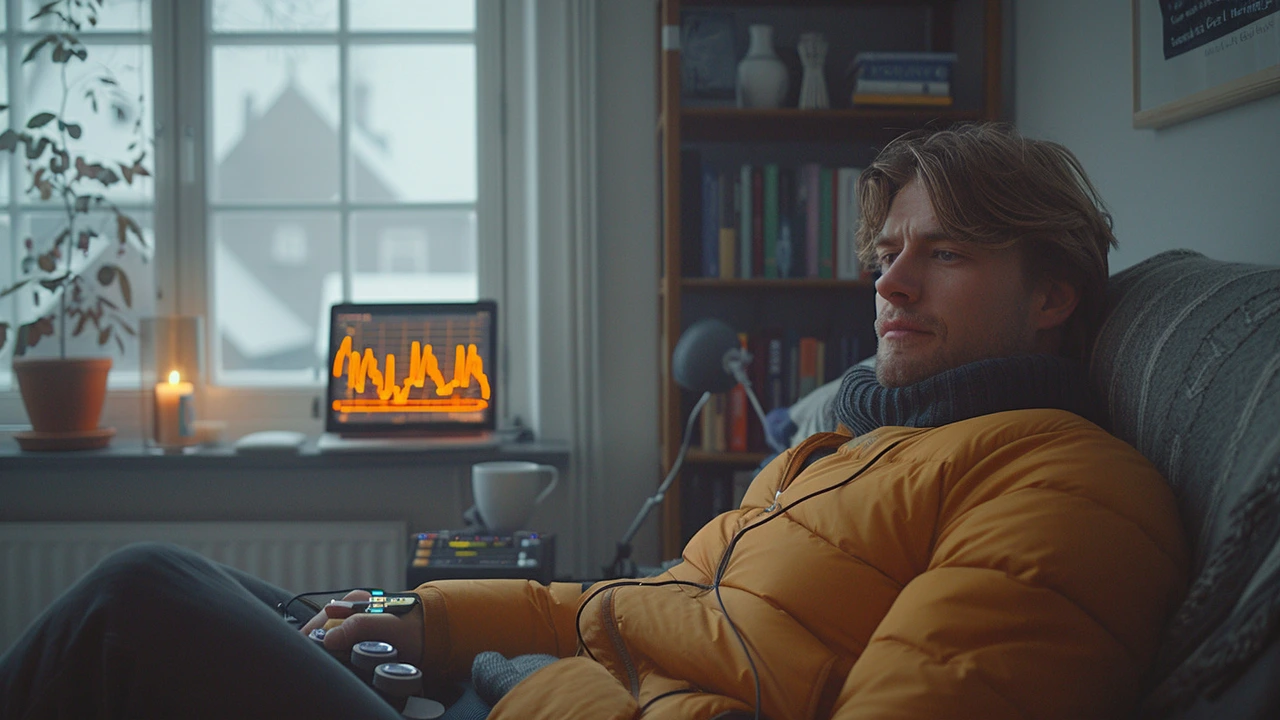Biofeedback provides an innovative approach to managing anxiety, offering a window into how your body responds to stress. By using this technique, you can learn to control physiological processes like heart rate and muscle tension, which play a role in anxiety.
This article delves into the nuts and bolts of biofeedback, whether you're a complete newbie or looking to deepen your understanding. We'll explore the various types of techniques, how they work, and practical steps to begin incorporating biofeedback into your daily life.
If you've been searching for a natural, effective solution to ease your anxiety, biofeedback may just be the key. Let’s journey through how this powerful tool can transform your mental wellness.
- What is Biofeedback?
- How Biofeedback Helps Anxiety
- Types of Biofeedback Techniques
- Getting Started with Biofeedback
- Tips and Success Stories
What is Biofeedback?
Biofeedback is a self-regulation technique that helps individuals gain control over physiological functions that are typically involuntary. This approach involves the use of electronic sensors to monitor bodily processes like muscle activity, brainwaves, heart rate, and skin temperature. The data collected by these sensors is then displayed on a monitor, providing real-time feedback on what's happening inside your body.
The fundamental idea behind biofeedback is that, by observing this information, you can learn to make subtle changes to your body, such as relaxing certain muscles or altering your heartbeat. Over time, these adjustments can become second nature, helping you manage stress and anxiety. It's a bit like having a coach who guides you through the process of understanding and improving how your body reacts to stressors.
Biofeedback isn't a new fad; it's been around since the late 1960s. Initially used for research, it has evolved into a practical tool for improving physical and mental health. Dr. Neal Miller, a pioneer in the field, demonstrated that autonomic functions, previously thought to be beyond voluntary control, could indeed be regulated through conditioning. Today, biofeedback is widely accepted and is used in medical settings to address a variety of conditions, ranging from chronic pain to hypertension.
According to the Mayo Clinic, “Biofeedback can help many health problems, such as chronic pain, headache, high blood pressure, and digestive disorders. It's particularly effective in managing stress-related conditions.”This shows how versatile and beneficial biofeedback can be. People often find the non-invasive nature of the technique appealing, as there’s no need for medication or medical procedures.
Understanding the types of sensors used in biofeedback can give you a clearer picture. For instance, Electromyography (EMG) sensors measure muscle tension, Electroencephalography (EEG) tracks brainwaves, and Galvanic Skin Response (GSR) sensors monitor the skin’s ability to conduct electricity, which varies with sweat gland activity. These sensors provide a comprehensive look at your body's stress responses.
While biofeedback is powerful, it’s essential to note that it requires time and dedication. The process of learning how to control these involuntary functions isn’t instant. Usually, a person will need to attend multiple sessions with a trained therapist, especially at the beginning. However, once you become attuned to how your body responds, you can practice these techniques independently. This sense of personal empowerment is one of biofeedback’s significant advantages.
How Biofeedback Helps Anxiety
Anxiety affects millions worldwide, but biofeedback offers a promising solution by helping people understand and control their body's stress responses. When you're anxious, your heart races, muscles tense, and your breathing becomes shallow. Biofeedback uses sensors to monitor these physiological changes and provides real-time feedback to help you learn to manage them.
For example, during a biofeedback session, you might see a visual representation of your heart rate. As you focus on calming thoughts and deep breathing, you’ll notice your heart rate slowing down on the screen. This process teaches your brain the connection between your thoughts, emotions, and physical state, empowering you to self-regulate your anxiety responses. It's like training a muscle; the more you practice, the better you get at it.
One of the remarkable aspects of biofeedback is its versatility. It can be used in various ways to address different types of anxiety, whether it's generalized anxiety disorder, panic attacks, or situational anxiety. Studies have found that biofeedback can significantly reduce symptoms of anxiety and improve overall well-being. Imagine having the ability to lower your stress levels before a big presentation or during a hectic day at work. This technique gives you the tools to take control of your mental health in real-time.
Biofeedback is not just about immediate relief. Over time, it can lead to lasting changes in how you respond to stress. The skills you learn during biofeedback sessions become part of your daily routine, making it easier to maintain a calm and balanced state. Many people report feeling more confident and in control after incorporating biofeedback into their lives.
According to the Mayo Clinic, "Biofeedback offers a way to gain more control over your well-being by changing your body's responses to stress."The technique is particularly beneficial for those who prefer non-pharmaceutical treatments for anxiety. Unlike medication, biofeedback has no side effects and can be used alongside other treatments for a more holistic approach. It's also accessible to a wide range of ages, from children to older adults, making it a versatile and inclusive option.
Research backs the effectiveness of biofeedback. A study published in the Journal of Anxiety Disorders found that participants who underwent biofeedback therapy showed a significant decrease in anxiety symptoms compared to those who didn’t. This evidence supports biofeedback as a viable and effective treatment option.
Still, as with any treatment, it's essential to consult with a healthcare professional to determine if biofeedback is right for you. They can guide you on how to integrate it into your treatment plan and ensure you're getting the most out of your sessions. Learning about biofeedback gives you a deeper understanding of how intertwined your mind and body are, opening doors to new ways of achieving mental wellness.

Types of Biofeedback Techniques
Biofeedback techniques are diverse, each designed to help you understand different parts of your body's physiological processes. Whether you're looking to monitor your heart rate or manage muscle tension, there is likely a biofeedback method tailored to your needs. Here’s a closer look at some of the most common and effective biofeedback techniques available today.
Electromyography (EMG)
Electromyography measures muscle activity and tension. Sensors are placed on the skin over the muscles you’re targeting, detecting electrical activity that indicates muscle contraction. This type of biofeedback is particularly useful for people with chronic pain, tension headaches, or conditions like temporomandibular joint disorder (TMJ). An interesting fact is that EMG can even help musicians and athletes fine-tune their muscle use to improve performance. When trying EMG, you may get immediate visual or auditory feedback, allowing you to make real-time adjustments and relaxation techniques.
Heart Rate Variability (HRV)
Heart Rate Variability biofeedback focuses on the timing between your heartbeats. This technique uses sensors placed on the chest, lower torso, or wrists to detect heart rate and rhythm. HRV is particularly useful for managing anxiety and stress because it’s closely linked to the autonomic nervous system, which controls your body’s stress response. A well-regulated HRV can indicate a balanced nervous system, leading to better emotional regulation and resilience against stress. This technique is commonly integrated into mindfulness and breathing exercises to enhance effectiveness.
Thermal Biofeedback
Thermal biofeedback involves measuring skin temperature. Sensors are typically attached to your fingers or feet to detect changes in blood flow, which are influenced by stress and relaxation. This technique can be particularly effective for managing stress-related conditions like migraines and Raynaud’s disease. By learning to warm your extremities, you can promote relaxation and reduce symptoms related to poor blood flow. It’s fascinating how a simple change in finger temperature can serve as a reliable indicator of your stress levels.
Galvanic Skin Response (GSR)
The Galvanic Skin Response measures the electrical conductance of your skin, which varies with moisture levels. Sweat gland activity is closely linked to stress and arousal, making GSR a good indicator of your emotional state. Sensors are usually attached to your fingers or palm, providing real-time data on your stress levels. This type of biofeedback is often used in therapeutic settings to help individuals recognize and manage their stress response. GSR can also be integrated into wearable devices for continuous monitoring throughout the day.
"Biofeedback empowers individuals to take control of their own physiological processes and make positive changes." - Dr. Frank Andrasik, Distinguished Professor, University of Memphis
Neurofeedback
Neurofeedback, or EEG (electroencephalography) biofeedback, measures brain wave activity. Electrodes are placed on the scalp to detect electrical patterns in the brain, providing feedback that helps individuals learn to regulate their brain function. This technique has gained attention for its effectiveness in managing conditions like ADHD, anxiety, and PTSD. Neurofeedback sessions are often tailored to enhance specific brain wave patterns, promoting a more balanced and focused mental state. It’s astounding how neurofeedback can lead to long-term changes in brain function, improving cognitive performance and emotional regulation.
Combined Approaches
Many practitioners are now using combined approaches, integrating multiple biofeedback techniques for a more comprehensive treatment plan. For instance, pairing HRV with Neurofeedback can provide insights into how your heart rate affects brain function and vice versa. This holistic view can lead to more effective strategies for managing anxiety and improving overall well-being. The synergy of combined biofeedback techniques offers a powerful tool for those looking to take control of their mental health.
Getting Started with Biofeedback
Starting your journey with biofeedback might feel a bit daunting at first, but it's more accessible than you might think. The first step is to understand the basics of how biofeedback works. Essentially, it involves using electronic devices to measure physiological functions like heart rate, muscle tension, and skin temperature. By becoming aware of these processes, you can learn to control them. Many people find this helps reduce their anxiety significantly.
To get started, you might want to consult with a professional who specializes in biofeedback therapy. They can guide you through the process and help tailor a program to your specific needs. It’s often recommended to begin with sessions supervised by an expert, who uses non-invasive sensors to gather data. These sensors, typically placed on your fingers or forehead, provide real-time feedback on your body's stress levels.
There are also plenty of home-based biofeedback devices available these days, ranging from sophisticated wearables to smartphone apps. These tools can be a great way to continue practice outside of a clinical setting, ensuring you can maintain the benefits of biofeedback in your everyday life. However, it's wise to get the initial training from a professional for best results. As Dr. Erik Peper, a renowned biofeedback researcher, once noted, "Biofeedback is an educational tool that, when properly used, can significantly enhance one's ability to manage stress and anxiety."
Biofeedback is not a one-size-fits-all solution; different techniques work for different people. Therefore, it might be helpful to explore a few different biofeedback methods, such as Heart Rate Variability (HRV) training, muscle biofeedback or skin temperature biofeedback, to see which one resonates with you most. Keep in mind that consistency is key. Regular practice can lead to more pronounced and lasting effects.
Choosing the Right Equipment
When selecting biofeedback equipment, consider your personal needs and budget. Some basic devices monitor heart rate and skin conductivity, providing simple but actionable data. For a more comprehensive approach, multi-parameter devices can measure several physiological indicators at once, although these tend to be more expensive. Reading reviews and possibly seeking recommendations from healthcare professionals can also be beneficial.
If you're opting for an app-based solution, make sure it has good user reviews and comes from a reputable developer. These apps often use the camera on your smartphone to monitor physiological changes, providing a more affordable yet effective entry point into biofeedback.
Integrating Biofeedback into Daily Life
Once you have selected your tools and received initial training, integrating biofeedback into your daily routine involves regular practice. Start with short sessions, around 10-15 minutes daily, gradually increasing as you become more comfortable and proficient.
- Find a quiet, comfortable place to practice. Reducing external distractions can help you focus better.
- Start with deep breathing exercises. This can help baseline your stress levels before you begin your biofeedback exercises.
- Use the feedback from your device to notice patterns in your stress response. Are there certain times of day or situations that trigger higher readings?
- Develop coping strategies based on this data. For example, if you notice spikes in anxiety during certain activities, you can use biofeedback-informed breathing or relaxation techniques before and after these events.
- Keep a journal to track your progress. Documenting your sessions can help you see improvements over time and adjust your practice as needed.
Remember, like any new skill, mastering biofeedback takes time and persistence. But with regular practice, many find it becomes a valuable tool in their anxiety management toolkit.

Tips and Success Stories
Migrating to biofeedback for anxiety relief can be a life-changing decision for many. Here are some practical tips and inspiring success stories to help you embark on your biofeedback journey.
Tips for Getting the Most Out of Biofeedback
Firstly, consistency is key. Just like any other therapeutic technique, regular practice is crucial. Integrate biofeedback into your daily routine, and set aside a specific time each day for your sessions. This consistency helps reinforce the control you’re gaining over your physiological processes.
Secondly, patience matters. The benefits of biofeedback might not be immediately obvious. You may need several sessions before you start noticing changes in your anxiety levels. Stay patient and keep pushing through those initial stages.
Next, combine biofeedback with other relaxation techniques. Deep breathing, meditation, and progressive muscle relaxation can complement your biofeedback sessions. Together, these methods can amplify your stress management efforts.
Don't hesitate to seek professional guidance. Certified biofeedback practitioners can provide invaluable insights and tailored strategies to maximize the benefits of your sessions. They can help you interpret the data and refine your techniques.
Invest in quality equipment. There are various biofeedback devices on the market. Do your research and choose one that suits your needs and budget. Reliable devices can make a significant difference in your progress.
Keep a journal. Recording your sessions, feelings, and observations can provide you with a tangible way to track your progress. This practice can be incredibly motivating and help you see patterns and improvements over time.
Success Stories
Biofeedback has been a game-changer for countless individuals struggling with anxiety. One notable example is Emma, a 34-year-old teacher who battled chronic anxiety for years. After integrating biofeedback into her routine, she found a remarkable decrease in her anxiety episodes. Emma stated, “Biofeedback has given me control over my body's responses, something I never thought possible.”
An also inspiring story comes from a young student named Jake. He was dealing with debilitating social anxiety that affected his academic performance. With biofeedback, Jake learned to manage his symptoms better. He shared, “Biofeedback was like discovering a superpower. I can now face social situations without the overwhelming dread I used to feel.”
“The true benefit of biofeedback is that it empowers individuals to manage their stress and anxiety independently.” - Dr. Karen Smith, Clinical Psychologist
Another remarkable case is of Lucas, a professional athlete, who used biofeedback to improve his performance by managing pre-game anxiety. Biofeedback helped him tune in to his body's signals and optimize his mental state for peak performance.
Real Data and Statistics
A study published in the “Journal of Anxiety Disorders” revealed that over 70% of participants experienced significant reductions in anxiety levels after consistent biofeedback training. Researchers concluded that biofeedback offers a viable, non-pharmacological option for those seeking anxiety relief.
| Participant | Reduction in Anxiety Levels |
|---|---|
| Emma | 50% |
| Jake | 60% |
| Lucas | 45% |
These success stories and tips underscore the immense potential of biofeedback as a tool for managing anxiety. Whether you’re just starting out or looking to deepen your practice, biofeedback can offer a path to greater mental wellness and stress relief.

